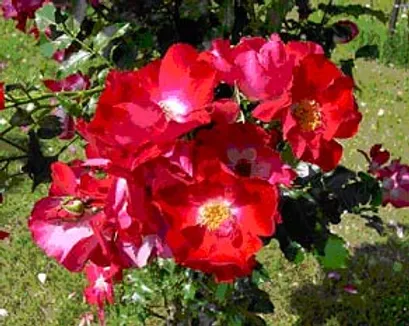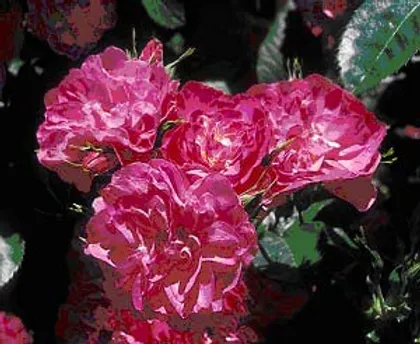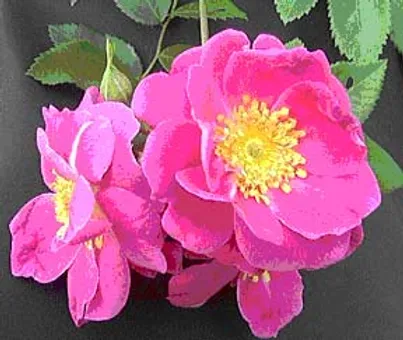By Linda Kimmel
Hybrid Kordesii Roses (HKor), a series of shrub roses developed by Kordes in the 1940s to early 1950s. The House of W. Kordes Shone, a German nursery, is a family-owned company, spanning four generations, and 100 years of rose breeding. Wilhelm Kordes founded the nursery in 1887. Later he was joined by his two sons, Wilhelm and Hermann. In 1941, the second generation Wilhelm planted seeds from a Max Graf (HRg). Was it sheer luck, mutation or expert hybridization skills? One of the seedlings turned out to be a tetraploid, 28 chromosomes instead of the usual 14, rendering it capable of crossing with modern roses.
The rose was a new strain, designated Rosa kordesii. Crossing R. kordesii with other modern roses gave rise to the series of shrubs called Hybrid Kordesii (HKor). Later in the 1970-80s, Dr. Felicitas Svejda, Canadian horticulturist, frequently utilized R.kordesii as a parent plant, developing the Canadian Explorer Series of roses.
HKor are well known for their shiny foliage, disease resistance and winter hardiness. In ARS rose shows, shrub roses are most often broken down into two classes: 1) classic shrubs, and 2) modern shrubs. According to ARS rules, HKor must be shown in the Classic Shrub division, and is eligible for the Best Classic Shrub certificate.
-
The Flower: Repeat blooming. Usually kordesii roses produce large quantities of clusters.
-
Colors: Many HKor are shades of pink, or red; but all colors are available, except blue.
-
Growth Habit: These are good landscape shrubs for a casual border in that they don’t like orderliness. Low maintenance. Due to long lanky canes, many HKor can be trained as climbers.
-
Size: They can grow 5 to 15 feet or more in every direction given the correct climate and growing conditions.
-
Disease Resistance: HKor are some of the toughest, most durable, robust, and disease resistant roses in the world.
-
Cold Tolerance: HKor are hardy without protection to Zone 3. As a tribute to their winter hardiness, they are grown very successfully in Alaska and Canada.
-
Scent: Varies. Most are slightly scented.
Here are some of the most popular Kordes Roses:
Dortmund.

ARS Merit rating 9.2. Probably one of the best-known HKor on the market. It is a medium red color with a white eye. Brilliant yellow stamens. Single (4-8 petals). Blooms in large clusters. Can be grown as a shrub or climber. Glossy green foliage. As with all of the HKor, it is very winter hardy and disease resistance. Hardy without protection from zone 4 to 9. Hybridized in 1955, [unknown seedling x R. kordesii]. Dortmund needs heavy deadheading and all day sun to keep it blooming. Scent is slight to none. Sets large orange hips.

John Cabot. (Canadian Explorer Series) ARS merit rating 8.9. It has large, semi-double blossoms that are deep pink to medium red color. Blooms in clusters of 3-10 roses. This rose is covered in blooms in late spring, and then has repeat blossoms throughout the rest of the summer. It can be trained to climb, reaching about 9 feet or so in Zone 4a. Canes can be left on a trellis without winter protection or cane dieback to zone 4a. John Cabot can be left untrained to form a large, arching shrub that will spread about 8-feet wide and get about 6-feet tall. It has healthy glossy foliage and is very winter hardy. Hybridized in 1978 by Dr. Felicitas Svejda. [R. kordesii x unknown seedling].
William Baffin (Canadian Explorer Series) ARS Merit Rating System 8.9.

Deep pink in color with bright yellow stamens. Blooms are about 3 inches across with 20 petals. Often grown as a climber, but will make an excellent freestanding shrub or hedge as well. William Baffin is an outstanding variety with complete disease resistance and winter hardiness to Zone 3. Hybridized in 1983 by Dr. Felicitas Svejda. [R. kordesii x unknown seedling].
Dortmund. Photo reprinted with permission Ashdown Roses: www.ashdownroses.com John Cabot. Photo reprinted with permission Bob Bauer: http://www.rose-roses.com William Baffin. Photo by Linda Kimmel




























































